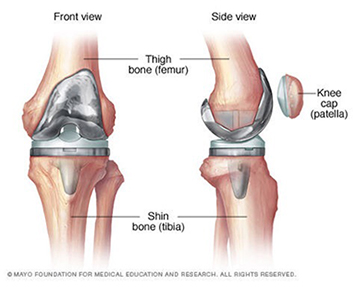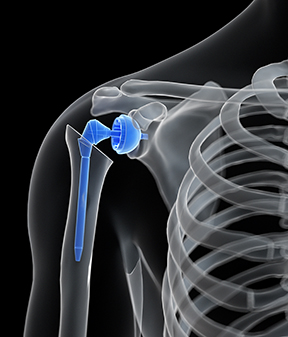
Orthopedics & Orthopedic Surgery (Bones)
Hip, Knee & Shoulder Replacement in La Crosse
When you have joint replacement surgery, a team of providers consisting of orthopedic surgeons, physical therapists and professional nursing staff will support you from your first appointment through recovery. You’ll benefit from having:
- Comprehensive education for you and your caregiver
- Family coaching tools
- Ongoing communication with you and the care team after you’re discharged from the hospital
- Group therapy and meals
By taking advantage of positive group dynamics, you’ll feel accountable to yourself as well as the others in your group. Drawing strength from the group environment provides an improved response to treatment with faster recovery times.
We provide the following joint replacement surgeries:
Learn more:
- Elbow replacement surgery
- Robotic orthopedic surgery offers greater precision and quicker recovery
Hip replacement surgery
Overview
Anterior surgical approach
The anterior (front) approach to total hip replacement involves the surgeon entering through the front of the upper thigh. Surgeons work between muscles, eliminating the need to detach muscles from the bone. Some in the field refer to this as a “muscle-sparing approach.” In addition, the anterior approach is performed with the patient supine (lying on his or her back), which facilitates use of X-ray guidance and increases placement accuracy of prosthetic hip components.
Typically, patients who undergo this procedure can expect slightly faster recovery, gait improvements and less need for walking aids. However, every patient is different, and recovery also depends on additional factors, such as body type and how the patient lives his or her life.
Patients who are active, in good physical shape and younger are often the best candidates for an anterior approach hip replacement.
Anterolateral (Watson-Jones)
The patient is typically lying on his or her side, and the hip is approached on the side and then around the front (anterior) portion of the hip. The hip is opened between the gluteus medius (muscle on the outside of the pelvis) and tensor fascia latae muscles (small muscle just in front of the hip joint). In most cases, at least a small portion of the gluteus medius muscle needs to be released to facilitate adequate exposure of the hip joint for hip replacement.
Posterior surgical approach
The posterior (back), or traditional, approach involves the surgeon entering just behind the side of the hip bone. It has been the most commonly used approach to hip replacement for the last few decades and thus one that most surgeons are familiar with. Additionally, it can easily be extended to provide greater exposure of the pelvic bone and femur (thigh bone). Because of this, the posterior approach is typically recommended over the anterior approach for revision surgeries.
Transgluteal
The patient again is side-lying, and the hip is approached through the side. The front portion of the hip abductor muscles (gluteus medius and gluteus minimus) are then removed from the greater trochanter to open up the hip joint. It’s considered an extensile approach that permits broader access to the pelvis bone around the hip socket and the femur (thigh bone).
This approach classically has the lowest risk of dislocation (ball coming out of the socket) but does carry the risk of a persistent limp from weakness of the hip abductor muscles.
Additional information
Knee replacement surgery
 Knee replacement surgery — also known as knee arthroplasty (ARTH-row-plas-tee) — can help relieve pain and restore function in severely diseased knee joints. The procedure involves cutting away damaged bone and cartilage from your thighbone, shinbone and kneecap and replacing it with an artificial joint (prosthesis) made of metal alloys, high-grade plastics and polymers.
Knee replacement surgery — also known as knee arthroplasty (ARTH-row-plas-tee) — can help relieve pain and restore function in severely diseased knee joints. The procedure involves cutting away damaged bone and cartilage from your thighbone, shinbone and kneecap and replacing it with an artificial joint (prosthesis) made of metal alloys, high-grade plastics and polymers.
In determining whether a knee replacement is right for you, an orthopedic surgeon assesses your knee's range of motion, stability and strength. X-rays help determine the extent of damage.
Your doctor can choose from a variety of knee replacement prostheses and surgical techniques, considering your age, weight, activity level, knee size and shape, and overall health.
The most common reason for knee replacement surgery is to relieve severe pain caused by osteoarthritis. People who need knee replacement surgery usually have problems walking, climbing stairs, and getting in and out of chairs. Some also have knee pain at rest.
Additional information
Shoulder replacement surgery
 Damage to your shoulder is painful and limiting. If a shoulder injury or condition is serious enough, a shoulder replacement may be the best option for regaining your mobility and independence.
Some common reasons why you’d need a shoulder replacement include:
Damage to your shoulder is painful and limiting. If a shoulder injury or condition is serious enough, a shoulder replacement may be the best option for regaining your mobility and independence.
Some common reasons why you’d need a shoulder replacement include:
- Arthritis
- Broken shoulder bone
- Conditions causing bone or joint deterioration
- Shoulder pain
- Torn rotator cuff
Types of shoulder surgery
Anatomical total shoulder replacement
This is the most common form of shoulder replacement and involves attaching a plastic lining to the socket to allow smooth movement. The surgeon removes the top of the arm bone and inserts a metal stem with a ball on the end.
Anatomical total shoulder replacements are often conducted when a patient suffers from osteoarthritis or rheumatoid arthritis in the shoulder.
Reverse total shoulder replacement
The rotator cuff is a group of muscles and tendons that hold the shoulder joint in place and allow you to move your arm and shoulder. Problems with the rotator cuff may cause weakness or pain and restrict movement. It may also cause damage to the shoulder joint.
Often, tendons can be repaired. However, if the tendons are severely damaged, an operation called reverse shoulder replacement may be a better way to improve the joint's function and reduce pain, especially if the joint is affected by arthritis.
This operation is also called reverse arthroplasty. "Arthro" means joint; "plasty" means to mold surgically.
In a reverse shoulder replacement, the normal ball-and-socket structure is reversed. An artificial ball is attached to the shoulder blade. An artificial socket is attached to the top of the arm bone. The large deltoid muscle that covers the shoulder is typically able to move the arm.